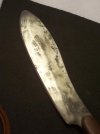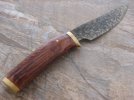-
The BladeForums.com 2024 Traditional Knife is ready to order! See this thread for details: https://www.bladeforums.com/threads/bladeforums-2024-traditional-knife.2003187/
Price is$300$250 ea (shipped within CONUS). If you live outside the US, I will contact you after your order for extra shipping charges.
Order here: https://www.bladeforums.com/help/2024-traditional/ - Order as many as you like, we have plenty.
You are using an out of date browser. It may not display this or other websites correctly.
You should upgrade or use an alternative browser.
You should upgrade or use an alternative browser.
antique a blade
- Thread starter hammerman
- Start date
- Joined
- Sep 23, 2006
- Messages
- 366
I hear tell that you can dapple the blade with mustard until it's covered, and leave it that way overnight. Appropriately enough, it's called a mustard patina.
For a slightly more even look you could submerge it overnight in a vinegar salt mix.
I kinda like the look of a scaly peice, so you could leave the HT scale on it.
If you leave it hammer finished instead of grinding it out, that by itself can look both quite attractive ans well as "old"
For a slightly more even look you could submerge it overnight in a vinegar salt mix.
I kinda like the look of a scaly peice, so you could leave the HT scale on it.
If you leave it hammer finished instead of grinding it out, that by itself can look both quite attractive ans well as "old"
- Joined
- Jul 21, 2008
- Messages
- 361
finish as youy normally would, then scratch the blade deliberately with a file, or sandpaper, wipe vinegar onto the bl;ade, then clean off, then on again, then off etc. for a while it gives the look of a blade that has achieved i's patina over many uses rather than just one massive one. Similarly mixing musatrd, vinegar, lemon juice, etc. and wiping them on/off separately can gfive interesting results.
- Joined
- Nov 27, 2004
- Messages
- 3,124
I talk about my mustard-vinegar patina technique in this thread. It works on carbon steel.
Looking forward to other responses.
All the best,
- Mike
Looking forward to other responses.
All the best,
- Mike
- Joined
- Feb 28, 2006
- Messages
- 3,494
Check out the recent thread of Ray Richard's on his recent knife.
http://www.bladeforums.com/forums/showthread.php?t=589151
He does a sweet job of it.
http://www.bladeforums.com/forums/showthread.php?t=589151
....The blade finish is the result of hand rubbing down to 2000 grit and an etch in Fc and water. I'll use a metal polish after the etch.
He does a sweet job of it.
Last edited:
- Joined
- Jul 26, 2008
- Messages
- 1,006
I've tried some different things. Some work good, others work really well. The following procedure I obtained through a bit of trial and error. I find I can get a nice etched look that looks a lot like random pattern damascus using this method. Start off getting the blade sanded down to approx. 320 to 400 grit. Apply liquid gun blue evenly till the blade gets nice and dark. Wipe of the excess. Then, using a spray bottle and some regular household bleach, lightly spritz over the entire blade to get a nice even spray pattern. The more separated and even the spray drops are, the more it'll look like damascus after it's done. You don't want to over-do it and flood out the pattern. Leave the blade sit to dry and etch. It doesn't take long, maybe a couple hours if that. After cleaning up the blade, use fine 0000 steel wool or Brasso silver polish to get a nice looking etched blade.
There is another method I use which simply entails using a spray bottle with some salt and vinegar water spritzed on the blade in the same way mentioned above. It gives a nice old look, but doesn't etch the blade like the bleach treatment. Here is a link to one of my knives with etching. http://www.facebook.com/photo.php?pid=1432296&l=aac95&id=588992124
There is another method I use which simply entails using a spray bottle with some salt and vinegar water spritzed on the blade in the same way mentioned above. It gives a nice old look, but doesn't etch the blade like the bleach treatment. Here is a link to one of my knives with etching. http://www.facebook.com/photo.php?pid=1432296&l=aac95&id=588992124
Last edited:
- Joined
- Oct 28, 2005
- Messages
- 2,606
- Joined
- Jun 17, 2001
- Messages
- 5,705
Check out the recent thread of Ray Richard's on his recent knife.
http://www.bladeforums.com/forums/newreply.php?do=newreply&p=6060795
He does a sweet job of it.
Phil, I don't call the finish in that post antique. It was done to get rid of some of the glare. In real life that blade is still pretty bright. I've tried many methods over the years including mustard and mustard mixed with several different additives. As an example of the look I have preferred for the last few years is here: http://bladegallery.com/shopexd.asp?id=85394&photo=3&size=b I can't remember for sure but I think it was the Wild Rose who first talked about the method I use. Most the knives and hawks that I had antiqued were done pretty much the sameway. Main ingredient is Cold Blue and the activator is bleach. I prefer the cold blue that come in a tube since its a little thicker. I use a wool dauber that is normally used for leather dye to apply the bluing. I'll first put a little of the bluing on a flat surface (old can of chew works the best) and then get a little bit on the dauber. The trick is to dab it onto the whole blade. Don't smear or paint it on, dab it on. The dabbing will create a texture. Let the bluing dry for a few minutes. You can also speed it up with hot air. After it is pretty much dry you want to totally submerge it in bleach. Leave it in the bleach till the bluing turns brownish. You want to rinse it off in water. Then go back in the bleach and again leave it until it turns brown again. Rinse again. Repeat as many times as you like but usually after the 3rd time I'll call it good. After you rinse it off go over it with steel wool. Its usually pretty dark then. You can leave it that way but I'll normally go over it with 2000 grit wet and dry. If you use this method don't put the blade in the bleach and forget it. This method goes beyond the surface of the steel. You can also speed it up more by warming up the bleach. After I have rubbed the blade with the steel wool I may put the blade in an etch to darken it up a touch. I'll us Braso to clean the blade for a final time.
- Joined
- Feb 28, 2006
- Messages
- 3,494
Ray, Yep, that's a different look, an antique'd one for sure. It never ceases to amaze me to learn of the various methods you guys develop, and master, to achieve your goals. Thanks for sharing! -Phil
- Joined
- Jul 26, 2008
- Messages
- 1,006
The gun blue and bleach method works really well. Raymond Richard's method is very similar to mine, I just tend not to leave it in the bleach so long. It's hard to see in the picture I posted, but it does turn out a really neat looking blade. I don't tend to like knives that are too "shiny" and polished up, they don't look as usable as a rugged looking antique blade. Here's a before and after of a knife I made to show you what I mean. This one was done with just the salt and vinegar spray treatment. My photography skills are a bit lacking, but.....
Before:
http:///www.facebook.com/photo.php?pid=1436493&l=c2d58&id=588992124
After:
http://www.facebook.com/photo.php?pid=1436495&l=6787b&id=588992124
I also give the brass guard an antiquing by using a small round diamond point on my Foredom rotary tool. Just lightly bounce and skip over the brass till it gets a nice even texture, then apply gun bluing, and lightly polish after.
Before:
http:///www.facebook.com/photo.php?pid=1436493&l=c2d58&id=588992124
After:
http://www.facebook.com/photo.php?pid=1436495&l=6787b&id=588992124
I also give the brass guard an antiquing by using a small round diamond point on my Foredom rotary tool. Just lightly bounce and skip over the brass till it gets a nice even texture, then apply gun bluing, and lightly polish after.
- Joined
- Oct 27, 2005
- Messages
- 2,527
- Joined
- Feb 17, 2007
- Messages
- 3,375
Nice looking knife Scott, The ivory you sent me is on a knife in the gallery. BTW. Money coming your way. Jim
- Joined
- Oct 27, 2005
- Messages
- 2,527
Nice looking knife Scott, The ivory you sent me is on a knife in the gallery. BTW. Money coming your way. Jim
I take it the ivory was good for your purposes then?
- Joined
- Jun 14, 2007
- Messages
- 835
I thought I would share some of my ideas on the aged look. The first pic is a older knife that has aged naturally. This pic gives you an idea of what I am going for. The older knives I have seen have all had diferent looks to the patinas they have so I try to very it a little each time. The second pic is one I aged with mustard and ferric chloride. The last pic is of two knives with just mustard. The thing with mustard is if you aply it uneven the patina will be streaky but thats o.k. Actually thats the good thing about it.
You can control the end look by apllying in patterns. The two knives with the mustard patina have a thumb print pattern. You dont actually see my thumb prints its more like star burst. I think that what happens is as the mustard dries the edge of wet mustard is where the most action takes place. This makes sense as water and air speads rust. I usually apply the mustard and leave it on for say 15 minutes rinse it some and then leave it for another 10 minutes and then finally wash all the dried on stuff off. I may or may not reapply the mustard depending on how it looks after the first time through.
I think I will have to try out the cold blue and bleach. Thanks guys.
You can control the end look by apllying in patterns. The two knives with the mustard patina have a thumb print pattern. You dont actually see my thumb prints its more like star burst. I think that what happens is as the mustard dries the edge of wet mustard is where the most action takes place. This makes sense as water and air speads rust. I usually apply the mustard and leave it on for say 15 minutes rinse it some and then leave it for another 10 minutes and then finally wash all the dried on stuff off. I may or may not reapply the mustard depending on how it looks after the first time through.
I think I will have to try out the cold blue and bleach. Thanks guys.
- Joined
- May 7, 2008
- Messages
- 93
I know they sell some stuff for speeding up copper shingle patina.. might be worth a try. Never tried it myself...but seems to do some stuff to copper..


